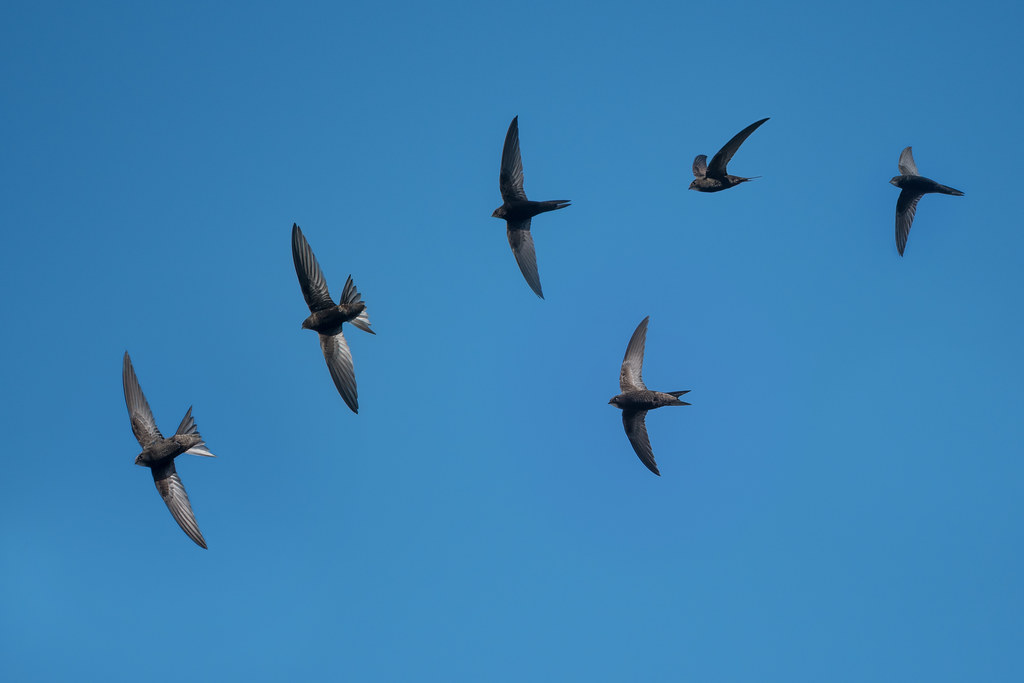
Tim writes: there does not seem to be a collective noun for Swifts other than the prosaic “flock”, and the implausible “scream”. It seems surprising that so many birds have special collective nouns yet the highly gregarious Swift has none. That’s probably because such terms were used by hunters (or collectors) and nobody in their right mind would want to hunt or collect a Swift. On 7th August the local Swifts were passing over my garden in noisy groups, and I wanted to collect a few photographs as they’d be gone in a few days. So I fired off a few dozen shots but I never had more than one bird in focus in any one shot. So I created a montage of half a dozen images, all taken within a few minutes of each other that morning. While I was staring at the skies I spotted a Hobby pass over my garden, which isn’t a frequent occurrence.
The name Swift is highly appropriate as they hold the record for level flight speed under their own power (69.3 miles per hour). But this was during a turbo-charged screaming flight, whereas the usual flight speed was 22-26 mph. Other birds like Peregrine Falcons can reach much greater speeds but only when freefalling using the power of gravity. They fly around with their beaks open catching insects which they store in a ball to bring back to their youngsters in the nest. Analysis of just 12 food balls revealed more than 300 species of insect and spider. It is thought that each Swift may catch 10,000 insects in a day, which is more (numerically) than any other British bird.
The other interesting thing about Swifts is that once they leave their nest, their feet won’t touch the ground for two or three years until they nest themselves. By this time the young Swift will have made two or three return journeys to sub-Saharan Africa. They eat, drink, sleep and even mate on the wing, only landing when they nest. The oldest known Swift was ringed as a nestling in Switzerland and was caught back there 21 years later, by which time it was estimated to have flown perhaps 3 million miles.
The scientific name Apus apus comes from the Greek ” a pous” meaning without foot. Swift legs are so small that it was once believed that they did not have any feet. If a Swift gets grounded it cannot spring back into the air like all other birds with normal sized legs. Several times I have found grounded Swifts and have saved their lives by launching them back into the air. An immensely satisfying thing to do. Speaking of Swift feet, they are known as pamprodactylous where the outer two toes can rotate freely to point forwards or backwards. Most birds have three toes forwards and a hind toe pointing back. When a Swift lands at the nest site all four toes point forwards.
[registration_form]
Woodpeckers can also rotate toes (but not to the extent of swifts).
There’s another dactyl word related to that.
The word for the two toes forward and two toes back is zygodactylous, and is found in woodpeckers, cuckoos and parrots. But my understanding is that their toes cannot rotate. Though I think osprey and owls have a rotatable forward-pointing toe, so sometimes they have two forward, and sometimes three. But I’m not aware that any birds other than swifts can rotate the backwards-pointing toe so they have all four toes pointing forward.
A reminder of warmer times this year, although the skies here are now wonderfully full of the daytime back and forth of many skeins of hundreds of pink footed geese.
While I’ve never heard of such activity, rather sadly I fear “and nobody in their right mind would want to hunt or collect a …” may not be a very accurate aphorism.
Given the diversity of bird species shot down as they migrate through Malta, Cyprus and other Mediterranean black-spots, I would be very surprised if swifts do not occasionally figure amongst the victims. I imagine they are not an easy target compared to many birds (as many photographers can attest), which may be their saving grace in this regard though.
Hope that you didn’t mean launching them back in the air literally. This is a big no no as they may not be ready to go and may crash land elsewhere out of sight.
Please see Swift First Aid and Carers Website for the correct way to help a downed swift